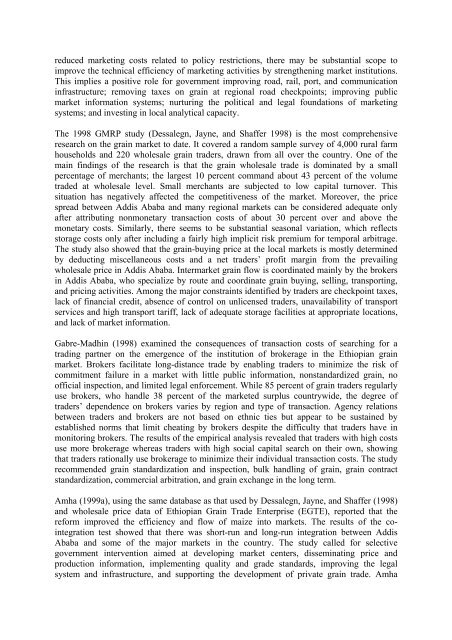The Future of Smallholder Farming in Eastern Africa - Uganda ...
The Future of Smallholder Farming in Eastern Africa - Uganda ...
The Future of Smallholder Farming in Eastern Africa - Uganda ...
Create successful ePaper yourself
Turn your PDF publications into a flip-book with our unique Google optimized e-Paper software.
educed market<strong>in</strong>g costs related to policy restrictions, there may be substantial scope to<br />
improve the technical efficiency <strong>of</strong> market<strong>in</strong>g activities by strengthen<strong>in</strong>g market <strong>in</strong>stitutions.<br />
This implies a positive role for government improv<strong>in</strong>g road, rail, port, and communication<br />
<strong>in</strong>frastructure; remov<strong>in</strong>g taxes on gra<strong>in</strong> at regional road checkpo<strong>in</strong>ts; improv<strong>in</strong>g public<br />
market <strong>in</strong>formation systems; nurtur<strong>in</strong>g the political and legal foundations <strong>of</strong> market<strong>in</strong>g<br />
systems; and <strong>in</strong>vest<strong>in</strong>g <strong>in</strong> local analytical capacity.<br />
<strong>The</strong> 1998 GMRP study (Dessalegn, Jayne, and Shaffer 1998) is the most comprehensive<br />
research on the gra<strong>in</strong> market to date. It covered a random sample survey <strong>of</strong> 4,000 rural farm<br />
households and 220 wholesale gra<strong>in</strong> traders, drawn from all over the country. One <strong>of</strong> the<br />
ma<strong>in</strong> f<strong>in</strong>d<strong>in</strong>gs <strong>of</strong> the research is that the gra<strong>in</strong> wholesale trade is dom<strong>in</strong>ated by a small<br />
percentage <strong>of</strong> merchants; the largest 10 percent command about 43 percent <strong>of</strong> the volume<br />
traded at wholesale level. Small merchants are subjected to low capital turnover. This<br />
situation has negatively affected the competitiveness <strong>of</strong> the market. Moreover, the price<br />
spread between Addis Ababa and many regional markets can be considered adequate only<br />
after attribut<strong>in</strong>g nonmonetary transaction costs <strong>of</strong> about 30 percent over and above the<br />
monetary costs. Similarly, there seems to be substantial seasonal variation, which reflects<br />
storage costs only after <strong>in</strong>clud<strong>in</strong>g a fairly high implicit risk premium for temporal arbitrage.<br />
<strong>The</strong> study also showed that the gra<strong>in</strong>-buy<strong>in</strong>g price at the local markets is mostly determ<strong>in</strong>ed<br />
by deduct<strong>in</strong>g miscellaneous costs and a net traders’ pr<strong>of</strong>it marg<strong>in</strong> from the prevail<strong>in</strong>g<br />
wholesale price <strong>in</strong> Addis Ababa. Intermarket gra<strong>in</strong> flow is coord<strong>in</strong>ated ma<strong>in</strong>ly by the brokers<br />
<strong>in</strong> Addis Ababa, who specialize by route and coord<strong>in</strong>ate gra<strong>in</strong> buy<strong>in</strong>g, sell<strong>in</strong>g, transport<strong>in</strong>g,<br />
and pric<strong>in</strong>g activities. Among the major constra<strong>in</strong>ts identified by traders are checkpo<strong>in</strong>t taxes,<br />
lack <strong>of</strong> f<strong>in</strong>ancial credit, absence <strong>of</strong> control on unlicensed traders, unavailability <strong>of</strong> transport<br />
services and high transport tariff, lack <strong>of</strong> adequate storage facilities at appropriate locations,<br />
and lack <strong>of</strong> market <strong>in</strong>formation.<br />
Gabre-Madh<strong>in</strong> (1998) exam<strong>in</strong>ed the consequences <strong>of</strong> transaction costs <strong>of</strong> search<strong>in</strong>g for a<br />
trad<strong>in</strong>g partner on the emergence <strong>of</strong> the <strong>in</strong>stitution <strong>of</strong> brokerage <strong>in</strong> the Ethiopian gra<strong>in</strong><br />
market. Brokers facilitate long-distance trade by enabl<strong>in</strong>g traders to m<strong>in</strong>imize the risk <strong>of</strong><br />
commitment failure <strong>in</strong> a market with little public <strong>in</strong>formation, nonstandardized gra<strong>in</strong>, no<br />
<strong>of</strong>ficial <strong>in</strong>spection, and limited legal enforcement. While 85 percent <strong>of</strong> gra<strong>in</strong> traders regularly<br />
use brokers, who handle 38 percent <strong>of</strong> the marketed surplus countrywide, the degree <strong>of</strong><br />
traders’ dependence on brokers varies by region and type <strong>of</strong> transaction. Agency relations<br />
between traders and brokers are not based on ethnic ties but appear to be susta<strong>in</strong>ed by<br />
established norms that limit cheat<strong>in</strong>g by brokers despite the difficulty that traders have <strong>in</strong><br />
monitor<strong>in</strong>g brokers. <strong>The</strong> results <strong>of</strong> the empirical analysis revealed that traders with high costs<br />
use more brokerage whereas traders with high social capital search on their own, show<strong>in</strong>g<br />
that traders rationally use brokerage to m<strong>in</strong>imize their <strong>in</strong>dividual transaction costs. <strong>The</strong> study<br />
recommended gra<strong>in</strong> standardization and <strong>in</strong>spection, bulk handl<strong>in</strong>g <strong>of</strong> gra<strong>in</strong>, gra<strong>in</strong> contract<br />
standardization, commercial arbitration, and gra<strong>in</strong> exchange <strong>in</strong> the long term.<br />
Amha (1999a), us<strong>in</strong>g the same database as that used by Dessalegn, Jayne, and Shaffer (1998)<br />
and wholesale price data <strong>of</strong> Ethiopian Gra<strong>in</strong> Trade Enterprise (EGTE), reported that the<br />
reform improved the efficiency and flow <strong>of</strong> maize <strong>in</strong>to markets. <strong>The</strong> results <strong>of</strong> the co<strong>in</strong>tegration<br />
test showed that there was short-run and long-run <strong>in</strong>tegration between Addis<br />
Ababa and some <strong>of</strong> the major markets <strong>in</strong> the country. <strong>The</strong> study called for selective<br />
government <strong>in</strong>tervention aimed at develop<strong>in</strong>g market centers, dissem<strong>in</strong>at<strong>in</strong>g price and<br />
production <strong>in</strong>formation, implement<strong>in</strong>g quality and grade standards, improv<strong>in</strong>g the legal<br />
system and <strong>in</strong>frastructure, and support<strong>in</strong>g the development <strong>of</strong> private gra<strong>in</strong> trade. Amha








